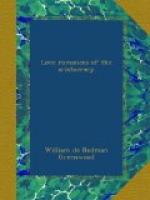The marriage day had actually been fixed when a letter was placed in Lady Jean’s hand, when on her way to the Court—a letter in which the Earl claimed his release as he no longer loved her. That the letter was a clever forgery never occurred to Lady Jean, who was so crushed by it that it is said she fled in disguise to France to hide her shame and her humiliation. Such was the tragic ending to Lady Jean’s first romance, which gave her such a distrust of man and such a distaste for matrimony that for thirty years she vowed she would listen to no avowal of love, however tempting.
During the long period, while youth was slipping from her, Lady Jean appears to have lived alone at Drumsheugh House, near Edinburgh, where she made herself highly popular by her affability, admired for her gifts and graces of mind, and courted for her rank and her lavish hospitality—paying occasional visits to her brother, the Duke of Douglas, whose devotion to her was only equalled by the alarm his eccentric behaviour and his mad fits of jealousy and temper inspired in her. That the Duke, who is described as “a person of the most wretched intellect, proud, ignorant, and silly, passionate, spiteful and unforgiving,” was scarcely sane is proved by many a story, one alone of which is sufficient to prove that his mind must have been unbalanced. Once when Captain Ker, a distant cousin, was a guest at the castle, he ventured to remonstrate with his host on allowing his servants, especially one called Stockbrigg, to rule over him; whereupon
“the poor Duke,” to quote Woodrow, “who for many years had been crazed in his brain, told this familiar, who persuaded him that such an insult could only be wiped out in blood. On which the Duke proceeded to Ker’s room and stabbed him as he was sleeping.”
It is little wonder that Lady Jean declined to live with a brother who was thus a slave to his own servants and to a temper so insane; but although their lives were led apart, and although, among many other mad delusions, the Duke was convinced that his sister had applied for a warrant to “confine him as a madman and she to sit down on the estate and take possession of it,” he was generous enough to make her a liberal allowance, and to promise that, if she married and had children, “they would heir his estate.”




